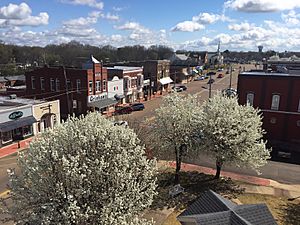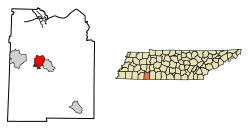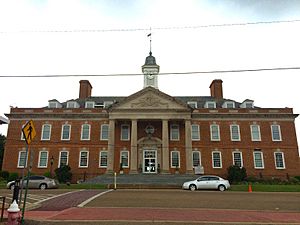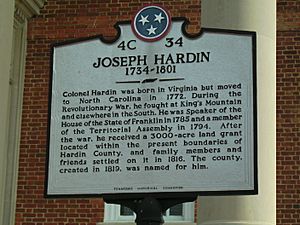Savannah, Tennessee facts for kids
Quick facts for kids
Savannah, Tennessee
|
|
|---|---|

City square
|
|

Location of Savannah in Hardin County, Tennessee
|
|
| Country | United States |
| State | Tennessee |
| County | Hardin |
| Settled | 1820s |
| Incorporated | 1833 |
| Government | |
| • Type | City Commission |
| Area | |
| • Total | 6.82 sq mi (17.67 km2) |
| • Land | 6.82 sq mi (17.67 km2) |
| • Water | 0.00 sq mi (0.00 km2) |
| Elevation | 443 ft (135 m) |
| Population
(2020)
|
|
| • Total | 7,213 |
| • Density | 1,057.47/sq mi (408.27/km2) |
| Time zone | UTC-6 (Central (CST)) |
| • Summer (DST) | UTC-5 (CDT) |
| ZIP code |
38372
|
| Area code(s) | 731 |
| FIPS code | 47-66720 |
| GNIS feature ID | 1300820 |
Savannah is a city in Hardin County, Tennessee, United States. It is also the county seat, which means it's where the main government offices for the county are located. In 2020, about 7,213 people lived here. Savannah is found on the east side of the Tennessee River.
This city has hosted the NAIA college football national championship game. This big event took place from 1996 to 2007. Savannah is also home to important historical places. One famous spot is the Cherry Family Mansion.
Contents
History of Savannah
The city was first called "Rudd's Ferry." This name came from James Rudd, an early settler. He started a ferry service in the area in the early 1820s. Later, a rich landowner named David Robinson bought Rudd's Ferry. The city was then renamed "Savannah." This new name honored Rudd's wife, Elizabeth, whose hometown was Savannah, Georgia.
The Battle of Shiloh
Hardin County was the location of a major event in 1862. This was the Battle of Shiloh, also known as the "Battle of Pittsburg Landing." It was a big fight during the Civil War. The battleground is about 10 miles (16 km) southwest of Savannah.
During the battle, Union General Ulysses S. Grant used the Cherry Mansion as his headquarters. This historic house is just off the city square.
Pickwick Landing State Park
Pickwick Landing State Park is located about 12 miles (19 km) south of Savannah. It was once a stop for steamboats. In the 1930s, during the Great Depression, the Tennessee Valley Authority (TVA) bought the land. They built a dam and created Pickwick Lake to make electricity.
In 1969, the state of Tennessee bought 681 acres (276 ha) from the TVA. This land was then turned into a state park for everyone to enjoy.
Geography and Location
Savannah is located slightly west of the center of Hardin County. It sits on the east bank of the Tennessee River. The area known as Olivet is right next to Savannah on its east side.
U.S. Route 64 goes through the middle of town. This road is called Bridge Avenue, Main Street, and Wayne Road in different parts of the city. US 64 heads east about 30 miles (48 km) to Waynesboro. It goes west about 21 miles (34 km) to Selmer.
Tennessee State Route 69 goes southeast for about 26 miles (42 km) to the Alabama border. From there, Florence, Alabama, is about 49 miles (79 km) southeast of Savannah. This route uses SR 69 and Alabama State Route 20.
The United States Census Bureau says that Savannah covers a total area of 6.82 square miles (17.67 km2). All of this area is land.
Savannah's Climate
Savannah experiences a varied climate throughout the year. Summers are generally hot, while winters are mild. The area receives a good amount of rainfall.
| Climate data for Savannah 6 SW, Tennessee (1991–2020 normals, extremes 1895–present) | |||||||||||||
|---|---|---|---|---|---|---|---|---|---|---|---|---|---|
| Month | Jan | Feb | Mar | Apr | May | Jun | Jul | Aug | Sep | Oct | Nov | Dec | Year |
| Record high °F (°C) | 79 (26) |
84 (29) |
90 (32) |
95 (35) |
99 (37) |
108 (42) |
112 (44) |
109 (43) |
111 (44) |
97 (36) |
89 (32) |
79 (26) |
112 (44) |
| Mean daily maximum °F (°C) | 51.1 (10.6) |
55.7 (13.2) |
64.9 (18.3) |
73.9 (23.3) |
81.3 (27.4) |
88.2 (31.2) |
91.3 (32.9) |
90.9 (32.7) |
85.6 (29.8) |
75.8 (24.3) |
63.9 (17.7) |
54.0 (12.2) |
73.0 (22.8) |
| Daily mean °F (°C) | 40.7 (4.8) |
44.4 (6.9) |
52.6 (11.4) |
61.5 (16.4) |
70.0 (21.1) |
77.4 (25.2) |
80.7 (27.1) |
79.7 (26.5) |
73.5 (23.1) |
62.5 (16.9) |
51.7 (10.9) |
43.7 (6.5) |
61.5 (16.4) |
| Mean daily minimum °F (°C) | 30.3 (−0.9) |
33.0 (0.6) |
40.4 (4.7) |
49.2 (9.6) |
58.7 (14.8) |
66.5 (19.2) |
70.1 (21.2) |
68.6 (20.3) |
61.4 (16.3) |
49.3 (9.6) |
39.5 (4.2) |
33.5 (0.8) |
50.0 (10.0) |
| Record low °F (°C) | −13 (−25) |
−10 (−23) |
6 (−14) |
23 (−5) |
32 (0) |
33 (1) |
45 (7) |
44 (7) |
33 (1) |
22 (−6) |
1 (−17) |
−10 (−23) |
−13 (−25) |
| Average precipitation inches (mm) | 4.88 (124) |
5.36 (136) |
5.64 (143) |
5.73 (146) |
6.19 (157) |
4.40 (112) |
4.91 (125) |
4.11 (104) |
4.28 (109) |
3.88 (99) |
4.19 (106) |
5.61 (142) |
59.18 (1,503) |
| Average precipitation days (≥ 0.01 in) | 10.9 | 10.7 | 12.3 | 10.7 | 11.3 | 9.8 | 10.2 | 8.8 | 7.3 | 8.0 | 9.6 | 12.4 | 122.0 |
| Source: NOAA | |||||||||||||
Population and People
Savannah has grown in population over the years. Here's how the number of people living in the city has changed:
| Historical population | |||
|---|---|---|---|
| Census | Pop. | %± | |
| 1850 | 466 | — | |
| 1870 | 328 | — | |
| 1880 | 1,006 | 206.7% | |
| 1890 | 1,087 | 8.1% | |
| 1920 | 758 | — | |
| 1930 | 1,129 | 48.9% | |
| 1940 | 1,504 | 33.2% | |
| 1950 | 1,698 | 12.9% | |
| 1960 | 4,315 | 154.1% | |
| 1970 | 5,576 | 29.2% | |
| 1980 | 6,992 | 25.4% | |
| 1990 | 6,547 | −6.4% | |
| 2000 | 6,917 | 5.7% | |
| 2010 | 6,982 | 0.9% | |
| 2020 | 7,213 | 3.3% | |
| Sources: | |||
2020 Census Information
The 2020 United States census counted 7,213 people living in Savannah. There were 2,658 households and 1,622 families. The table below shows the different groups of people living in Savannah based on the 2020 census:
| Race | Num. | Perc. |
|---|---|---|
| White (non-Hispanic) | 6,083 | 84.33% |
| Black or African American (non-Hispanic) | 496 | 6.88% |
| Native American | 23 | 0.32% |
| Asian | 68 | 0.94% |
| Other/Mixed | 369 | 5.12% |
| Hispanic or Latino | 174 | 2.41% |
Famous People from Savannah
Many notable individuals have connections to Savannah. These people have made contributions in various fields:
- John Barnhill – A football player, coach, and sports leader in colleges.
- Stubby Clapp – A Major League baseball player and coach.
- Geron Davis – A talented musician and composer.
- Hank DeBerry – A Major League baseball catcher from the early 1900s.
- Otis Floyd – He was the president of Tennessee State University. He was also the first African American Chancellor of the Tennessee State Board of Regents.
- Simon Haley – A college professor and administrator. He was the father of famous author Alex Haley.
- W. S. Holland – A rock-and-roll drummer for musicians like Carl Perkins and Johnny Cash.
- Jim Hardin – A Major League pitcher who played from 1967 to 1973. He won the World Series in 1970.
- Tom Hampton – A musician who plays many instruments. He is also a session musician, sideman, singer, and songwriter.
- Bolden Reush Harrison – A naval officer who received the Medal of Honor.
- Chad Harville – A Major League pitcher.
- Granville Hinton – A politician.
- Myles Horton – An educator and a leader in the civil rights movement.
- Vernon McGarity – An Army Technical Sergeant who received the Medal of Honor.
- Elizabeth Patterson – An actress known for films and her role on I Love Lucy.
- Randy Rinks – A businessman and politician.
- Herman L. Wolfe, Sr. – A politician.
- Darryl Worley – A country music performer.
See also
 In Spanish: Savannah (Tennessee) para niños
In Spanish: Savannah (Tennessee) para niños



